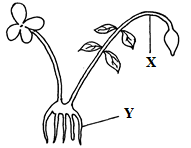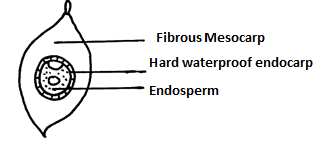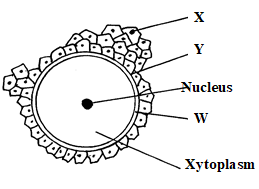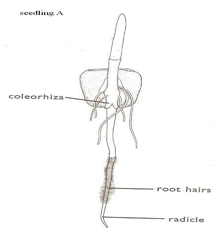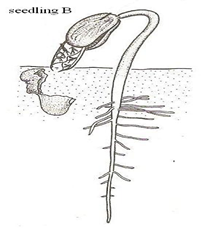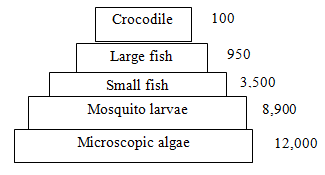INSTRUCTIONS TO CANDIDATES
- Answer All questions
- What is meant by the term sex linkage. (1mk)
- Part of one strand of DNA molecule was found to have the following sequence
G-C-C- G – A – T- T – T – A – C – G – G
What is the sequence- of the complimentary DNA strand? (1mk)
- On a m-RNA strand copied from this DNA portion? (1mk)
- State two regions in a plant where the end products of photosynthesis are translocated to? (2mks)
- With reference to circulatory system only give two reasons why birds and mammals are more active compared to other organisms? (2mks)
-
- What three characteristics are used to divide the phylum Arthropoda into classes? (3mks)
- The diagram below shows an organisms from a division in Kingdom plantae. Study it and answer the questions that follow.
- Identify the division from which the plant was obtained. (1mk)
- Name the parts labelled X and Y (2mks )
- X…………………………………………………………..
- Y……………………………………………………………
- What is the relationship between a genus and a species? (1mk)
- A drawing of 3 cm was made of a giant spider whose actual length was 7cm. calculate the magnification of the drawing? (3mks)
- Explain why osmosis is described as a special type of diffusion? (1mk)
- The following table shows the estimated number of organisms recorded in a dam.
Organisms Number Small fish 3500 Microscopic algae 12000 Crocodiles 100 Large fish 950 Mosquito larvae 8900 - Construct a possible food chain for the dam? (1mk)
- Construct a pyramid of numbers for the given data? (1mk)
- Explain the shape of pyramid obtained? (2mks)
-
- Explain why leaves of most plants are thin and broad. (2mks)
- State the function of the following enzymes during digestion in the stomach?
- Pepsin (1mk)
- Renin (1mk)
- Explain the following:
- Respiratory surface must be moist? (1mk)
- Respiratory surface must be thin (1mk)
- Palisade cells are cylindrical shaped and arranged with long axis perpendicular to the leaf surface. (1mk)
- The diagram below represents the vertical section of a fruit.
- Suggest the possible agent of dispersal of this fruit. (1mk)
- Explain two observable features that adapt the fruit to its mode of dispersal. (2 mks)
- Explain why the body temperature of a healthy person rises slightly during humid days? (2mks)
-
-
- Name the respiratory surface in insects. (1mk)
- State any one feature that adapts the structure named in a(i) above to its function. (1mk)
- Why are the fish gills highly vascularized? (1mk)
-
- State the function of the following organelles:
- Granulated Endoplasmic reticulum (1mk)
- Nucleolus (1mk)
- State two gaseous exchange sites in plants? (2mks)
- The diagram below shows an apparatus used during collection of specimen in biological study.
- Identify the apparatus? (1mk)
- What is the use of the apparatus named above? (1mk)
- List three limitations of fossil records as an evidence of organic evolution? (3mks)
- Distinguish between enzyme co-factors and co-enzymes? (2mks)
- Give two reasons for the rapid growth during the exponential phase of growth curve? (2mks)
- Give two reasons why Carolus Linneaus preferred the use of latin language in the scientific naming of living organisms. (2mks)
- State three roles played by active transport in living organisms. (3mks)
- List three factors affecting the rate of respiration? (3mks)
- Study the diagram below and answer the questions that follow.
- Identify the cell (1mk)
- Label the parts X,Y and W (3mks)
- X……………………………………………………………………………………………
- Y……………………………………………………………………………………………
- W……………………………………………………………………………………………
- Explain why it is becoming more difficult to treat malaria using chloroquine? (2mks)
- State two ways by which the ileum is adapted for absorption of food materials? (2mks)
- Name two processes that contribute to variation during gamete formation? (2mks)
- Damage to the mammalian liver may lead to indigestion of fats. Explain this observation. (2 mks)
- Name the disease of blood characterized by
- Abnormally large number of white blood cells. (1 mk)
- Cresent-shaped haemoglobin instead of the normal biconcave shape. (1 mk)
- During a strenuous exercise the chemical process represented by the equation below takes place in the human muscle cells.
C6H12O6 → 2CH3CH(OH)COOH + 150KJ
(Substance X)- Name the process represented above . (1 mk)
- Name substance X (1mk)
- The diagram below represents a stage of growth in two different seeds.
- Identify the type of germination exhibited by seedlings A and B. [2 marks]
Seedling A…………………………………………………………………………………………………………………….
Seedling B…………………………………………………………………………………………………………………… - State the role of oxygen during germination. [1 mark]
- Account for the loss of weight in cotyledons in germinating seeds. [1 mark]
-
- State the role of juvenile hormone during metamorphosis in insects. [1 mark]
- Name the glands that secrete juvenile hormone [1mark]
- Identify the type of germination exhibited by seedlings A and B. [2 marks]

MARKING SCHEME
- These are genes located on the sex chromosomes and are transmitted together with those determine sex. 1 mk
-
- C – G – G – C – T – A – A – A – T – G – C – C 1 mk
- C – G – G – C – U – A – A – A – U – G – C – C 1 mk
-
- The growing and developing regions such as shoots, leaves, flowers, fruits and roots
- Storage organs or tissues such as tubers, corns, bulbs, rhizomes and seeds.
- The secretors organs such as nectar glands in some insect pollinated plants such as bananas
any 3x1=3 mks
-
- Deoxygenated and oxygenated blood do not mix
- Blood is at a higher pressure once the heart pumps it twice.
2x1=2 mks
-
-
- Number of limbs
- Presence and number of antennae
- Number of body parts
3x1=3mks
-
- Bryophyta
- X – Seta
Z – Rhizoid rej Rhizoids.
-
- A species is a subset of genus i.e. one genus contains several species. 1x1=1 mk
- Magnification = (Length of drawing) √1
(Length of real object)
= 3cm = 0.429 √1
7cm
=X 0.43√1
1x3=3mks - Because it involves movement of solvent (water) molecules from their region of high concentration to region of low concentration across a semi permeable membrane.
1x1=1mk -
- Microscopic algae → mosquito larvae → small fish → large fish → crocodile
NB: mark as a whole
1x1=1 mk -
1x1=1 mk -
- Body size of the organism increase at each trophic level from the base as their numbers decrease.
- At each trophic level much of the energy obtained is lost in respiration thus fewer organisms can be supported at the succeeding level. 2 mks
- Microscopic algae → mosquito larvae → small fish → large fish → crocodile
-
-
- Thin
To reduce distance for diffusion of gases.
To reduce distance for sunlight to reach the photosynthetic cells. 1x1=1 mks - Broad
To provide large surface area for maximum light absorption. 1x1=1 mks
- Thin
-
- Pepsin – Breaks down proteins into peptides. 1x1 = 1 mks
- Renin – Digests protein caseinogens in milk to casein (curd) 1x1=1mks
-
-
- Moist o dissolve the diffusing gases across the respiratory surface. 2 mks
- Thin to reduce distance covered by diffusing gases i.e. for the gases to diffuse through short distance. 1mks
- Many palisade cells in a small area to enable them receive maximum sunlight.
1x1=1 mk
-
- Water dispersal. 1x1= mk
-
- Has a water proof endocarp for buoyancy. 2mks.
- Mesocarp is fibrous and spongy to trap air.
- This is because during humid day, there is low rate of sweating; since less water is lost from the body surface, leading to less heat loss through sweat hence body temperature tend to rise slightly. 1x2=2 mks
-
-
- Tracheoles.
- Thin epithelium for respiratory gas to diffuse through a short distance;
- Moist to dissolve respiratory gases.
- numerous to increase surface area for gaseous exchange.
1x1=1 mk
- To create a steep diffusion gradient after transport of oxygen gas. 1 mk.
-
-
- Helps in the transport of proteins. 1 mk
- Manufacture of ribosomes 1 mk
-
- Stomata;
- Lenticels of woody plants
- Cuticles 3x1=3 mks
-
- Pitfall trap
- For catching crawling animals.
-
- Distortion of parts of fossils during sedimentation hence can give wrong impression of the structure;
- There was several missing links of fossils records as some parts or whole organism decomposed, some scavenged upon and conditions may not be conducive for fossilization (O.W.T.T.E).
- Destruction of fossils by geological activities like earthquakes, faulting and mass movement.
3x1=3 mks
- Enzymes cofactors are non-proteinous substances which activate enzymes; while co-enzymes are organic non-protein molecules that work is association with particular enzymes. (Mark as a whole) 2 mks
-
- Cells have adjusted to the new environment
- Food and other factors are not limiting hence no competition for resources.
- Rate of cell increase is higher than cell death.
- There is an increase in the number of cells dividing
First two 1x2=2 mks
-
- Latin language was widely spoken and used by scientists during his time;
- Local names used previously could not be understood by everyone thus Latin language enhanced scientific communication worldwide. 1x2=2 mks
-
- Excretion of waste products from the body cells.
- Absorption of digested food from alimentary canal of animals in the blood stream.
- Absorption of some minerals salt from soil by plant roots.
- Accumulation of substances into the body to offset osmotic imbalance in arid and saline environment.
- Reabsorption of sugars and some salts by the kidney. 3x1=3 mks
-
- Oxygen concentration
- Presence or absence of hormones
- Substrate concentration
- Surface area to volume ratio/body size of an organism. 3x1=3 mks
-
- Mature human ovum 1mk
- X – follicle cell
Y – viteline membrane 1mk
W – Plasma membrane 1mk
- Some malaria plasmodium developed resistance; to chloroquine drug; through mutation; those resistant individuals transmit the characteristic to their offspring through reproduction thus establishing a new population of resistant forms. 2 mks
-
- It is long to provide large surface area for absorption.
- It is numerous to bring digested food into close contact with walls of the ileum for easier absorption.
- Highly coiled to slow down movement of food, allowing more time for absorption.
- Higher surface has large number of villi and micro-villi which increase the surface area for absorption of end products of digestion.
- Presence of thin layer of cells through which digested food diffuses.
- Presence of tense network of blood capillaries in villi into which nutrients are absorbed.
- Presence of lacteals in the villi for absorption of fatty acids and glycerol. 2x1=2 mks
-
- Independent assortment
- Crossing over 2x1=2 mks
- Damage lead to failure of liver to produce bile; bile carries out emulsification of fats; 2 mks
-
- Leukemia. 1 mk.
- Sickle cell Anaemia. 1 mk.
-
- Anaerobic respiration. (1 mk)
- Lactic acid. 1 mk.
-
- A- Hypogeal germination.
B- Epigeal germination. 2 mks. - Its used in oxidation of stored food substances in the seedto release energy for growth. (1 mk)
- Due to breakdown of stored food to yield energy for growth. (1 mk)
-
- It leads to formation of larval cuticle. (1 mk)
- Corpora allata. (1 mk)
- A- Hypogeal germination.
Join our whatsapp group for latest updates
Tap Here to Download for 50/-
Get on WhatsApp for 50/-
Download Biology Paper 1 Questions and Answers - Momaliche Post Mock 2020 Exam.
Tap Here to Download for 50/-
Get on WhatsApp for 50/-
Why download?
- ✔ To read offline at any time.
- ✔ To Print at your convenience
- ✔ Share Easily with Friends / Students

